Assessment of factors influencing job satisfaction among healthcare workers' in public hospitals in Nairobi County, Kenya
1Cyrus Memo Lifuleze, 2Faith Hope Muhonja, 3Joseph Muchiri
Abstract
Background: According to (Kalinski, 2020) Job satisfaction is a complex combination of psychological, emotional feeling and other environmental factors that can affect an employee positively and give them a sense of achievement on the job. Further, He implys that job satisfaction can be linked to doing a job one enjoys, being productive and getting positive intrinsic rewards like enthusiasm, and contentment. On March 14, 2024 the healthcare worker’s through their union representatves (KMPDU & KNUN) announced a nationwide strike in Kenya. This strike lasted for 56 days and was called off on May 8th 2024 after negotiations, the government officials agreed to some of the union demands. (MoH, 2024). It is evident that Healthcare workers are dissatisfied and the link to the major causes is not clear.
Objective: This study sort to investigate the factors influencing job satisfaction among healthcare workers' in public hospitals in Nairobi County, Kenya based on Herzberg’s Motivation Theory.
Methodology: This study employed a cross-sectional research design, targeting healthcare workers from five select Hospitals in Nairobi County, Kenya. A sample of 400 participants was selected using stratifed random sample based on proportioanl allocation. The data collection instrument was self-administered questionnaires and analysis done using the SPSS software, version 26.0, with the level of significance set at 0.05. Analyzed data was presented using tables with both descriptive, and inferentiall statistics i.e. Chisquare, Odds Ratios and Confidence Intervals.
Results: The study found that promotions ( p-value<0.001) with OR =1.790 and 95% CI = (1.090, 2.939), Training and development (p-value<0.001) with OR = 1.960 and 95% CI = (1.214, 3.165), Communication (p-value=0.001) with OR = 1.189 and 95% CI = (0.687, 2.059), Supervision (P-Value < 0.001) with OR = 1.380 and 95% CI = (0.805, 2.365), quality of buildings in terms of space (p-value<0.001) with OR = 1.505 and 95% CI = (0.924, 2.453), Equipment adequacy (p-value<0.001) with OR = 2.871 and 95% CI = (1.698, 4.854), Availability of PPEs’ (p-value=0.022) with OR = 2.394 and 95% CI = (1.316, 4.357), and Availability of amenities such as toilets and water (p-value=0.04) with OR = 1.844 and 95% CI = (1.458, 2.556) had a statistically significant effect on satisfaction/dissatisfaction by Healthcare workers.
Conclusion: The study was able to established that there are factors determining job satisfaction among healthcare workers in Public hospitals in Nairobi County, Kenya. They include salaries, fringe benefits, training and development, recognition and reward, supervision and management, communication, equipment and utilities, lighting and ventilation, and conducive work environment. Over (70%) of the respondents were not satisfied with their work environment. This study recommends that employers should come up with clear guidelines on rewards such as merit-based promotions, training, and development opportunities through programs such as in-service training and compensation for extra training that HCWs incur expenses for, and more resources should be invested towards the construction of more hospital spaces and improving the quality of the available hospital spaces.
Keywords: Healthcare workers, Hezenberg Theory, satisfaction/dissatisfaction, Service delivery, Strike.
Introduction
According to (Kalinski, 2020) Job satisfaction is a complex combination of psychological, emotional feeling and other environmental factors that can affect an employee positively and give them a sense of achievement on the job. Further, He implys that job satisfaction can be linked to doing a job one enjoys, being productive and getting positive intrinsic rewards like enthusiasm, and contentment. Job satisfaction is a key ingridient that can lead to work recognition, and promotion.
Healthcare delivery is complex and due to it’s nature of dealing with human beings, it calls for a motivated healthcare workforce who will work with close coordination and coorperation. In Kenya, healthcare services is delivered through a grid of about 4700 health facilities encompassing both the Public and Private sector which includes private for-profit, NGO, and FBO facilities. The public sector has the larger share with about 51 % of the overall number of facilities. (R Muga, 2023). The structure of the healthcare system in the Public sector according to the 2010 constitution through devolution was split into the County hospitals and the National Teaching and Referral hospitals which are the apex. The County hospitals are overseen by the County governments whereas the National Teaching and Referral hospitals are governed by the National government through the Ministry of Health (Ogosi, 2020).
The health care system in Kenya is faced with many challenges, including shortages of drugs, inadequate workforce, and insufficient funds. Between 2010 and 2020 there were eight countrywide strikes and a lot more county strikes (IntraHealth, 2021). In 2017, a 100-day doctors’ strike dragged on for 150 days. The strike was called off on 14th March 2017 when the Government signed an agreement and a Retern To Work Formula RTWF) with KMPDU and KNUN officials. (AL JAZEERA, 2017). On 9th September 2020, Kenyatta National Teaching and Referral Hospital issued a letter notice of a strike which was to commence on 7th December 2020. On March 14, 2024 the healthcare worker’s through their union representatves (KMPDU & KNUN) announced a nationwide strike. This strike lasted for 56 days and was called off on May 8th 2024 after negotiations, the government officials agreed to some of the union demands. (MoH, 2024).
Although healthcare worker strikes have turned into a universal issue with escalating challenges in several nations, the increased frequency affects health professionals’ roles in the health sector leading to poor service delivery, dissatisfaction among patients, and low quality of services. It is evident that Healthcare workers are dissatisfied and the link to the major causes is not clear.
The objective of this study was to investigate the factors influencing job satisfaction among healthcare workers' in public hospitals in Nairobi County, Kenya based on Herzberg’s Motivation Theory. Frederick Herzberg’s Motivation Theory provides two elements that affect motivation in the workplace. Hygiene elements include Pay, Company Policies and administrative policies, Fringe benefits, Physical Working conditions, Status, interpersonal relations, and Job Security. These elements cause an employee to be less productive if they are not available while Motivating elements include Recognition, Sense of achievement, Growth and promotional opportunities, Responsibility, and Meaningfulness of work. These elements inspire an employee to work harder if available. This means that a productive environment can be generated by addressing the factors that influence employee job satisfaction. The use of Herzberg’s motivational theory helped to determine the factors that influence satisfaction and dissatisfaction among the Healthcare workers of the five selected hospitals in the study.
In applying the use of Herzberg’s motivational theory, a recent study was conducted by (Verma, 2019). The study reported that 75.3% of healthcare workers were dissatisfied with their working environment, salary, promotion, and benefits, whereas the relationships with leaders and co-workers were satisfaction factors. In an earlier study pay, promotion, training and development, relations with supervisors, poor working conditions, and organizational policies were the main factors for job dissatisfaction among health workers in eastern Ethiopia as per (Geleto, 2019) whereas, Lack of professional development and training opportunities reported by 90% of the medical professionals as the most important factor affecting their job satisfaction. On the other hand, the relationships with leaders and peers contributed most to satisfaction, whereas the salary was a dissatisfaction factor. Given this scenario, the use of Herzberg’s motivational theory was best to help determine the factors that demoralize healthcare workers and in turn encourage strikes due to dissatisfaction.
According to (Du Plessis and Van Niekerk, 2017), motivating factors relate to issues such as training and development, recognition and rewards, and communication. Further, (Sukumaran, 2020) contends that social support emanating from senior management is a key motivating factor for employees since it helps them relieve stress related to their work and ensures that the efforts of employees are recognized. Job enrichment as outlined in (Kassa, 2022) is also a key construct of motivation for employees. Job enrichment is also a motivating factor, it entails adding tasks to employees to give the employee a feeling of empowerment in their workplace (Novianty & Evita, 2018). Employees’ training and availing of opportunities for training enable employees a feel of empowerment and thus commitment to their work. (Kibwana, 2018) undertook a study in Ethiopia to evaluate the causes of strikes among anesthetists working in public hospitals. Based on 252 respondents, supervision influence was assessed and its influence on engagement in strikes. Among the aspects of supervision that were found to cause strikes included supervision fairness in policy application and in his/her practices especially when conducting appraisals and the supervisor’s availability to respond to issues related to the organization affecting the employees.
In Iran, (Daneshkohan, 2020) evaluated aspects of supervision that influenced nurses’ engagement in strikes. Through a 250-sample size from 55 healthcare facilities, the findings revealed the supervisory skills of those in senior management positions to be insufficient thus leading to unrest. The behaviors of supervisors were found to also lead to conflicts which would trigger industrial unrest among nurses. (Rahayu, 2019) found the unwillingness of an organization to invest in the development and training of employees to contribute to cause strikes in the long run. Employees cited failure by employers to impart them with the capability and skills required for the evolving health sector to be associated with their striking. Research by (Rahayu, 2019) showed more likelihood for employees to engage in strikes in organizations that had no or fewer training programs as compared to those with rampant training programs.
According to (Kabir & Parvin, 2021), Environmental factors relate to working conditions such as the physical environment comprising of attractive features, for example, buildings, ventilation, lighting, privacy, furniture, comfort, and quality of sound. Further, environmental factors denote working conditions represented by an atmosphere that is pollution-free and contains the necessary equipment for HCWs to discharge their services (Wilton, 2019). If the environment in the workplace is good, employees become stress-free and are therefore satisfied making it less likely for them to take part in strikes. On the other hand, an organization that is poorly equipped leads to increased unrest by the workers.
A study by (Prasad, 2019) conducted a study on workplace conditions in the West Bengal public sector. The focus was on nurses working in public hospitals. The study noted that the work environment should be safe and healthy to set employees free from hazards such as health hazards. It should also enhance good mental health, well-being, and personal safety. A poorly planned workplace has a significant effect on the morale of Healthcare workers. It can also lead to poor motivation and reduced satisfaction which are triggers for strikes (Liao & Chuang, 2019).
Methodology
The study utilized a cross-sectional research design, targeting Nurses, Doctors, Clinical Officers, Other Medics, and the Support staff in Nairobi County, Kenya, specifically those working at Pumwani Maternity Hospital, Mama Lucy Kibaki Hospital, Ngara Health Center, Kenyatta National Teaching and Referral Hospital, and Mbagathi Hospital. A sample of 400 participants was selected using a stratifed random sample based on proportioanl allocation. The data was collected using self-administered questionnaires and analysis was done using the SPSS software, version 26.0, with the level of significance set at 0.05. Analyzed data was presented using tables with both descriptive, and inferentiall statistics i.e. Chisquare, Odds Ratios and Confidence Intervals.
Inclusion Criteria
The respondents that were eligible for the study were;
- Permanent Nurses, Doctors, Clinical Officers, Other Medics, and the Support staff.
- Healthcare workers who had been working in the facilities for one year and above.
Exclusion Criteria
The respondents that were excluded from the study were;
- Healthcare workers who did not sign the informed consent to participate in the study.
Results
Response rate
400 healthcare workers were approached to participate in the study. However, only 346 (86.5%) participants concented and completely filled the questionnaires.
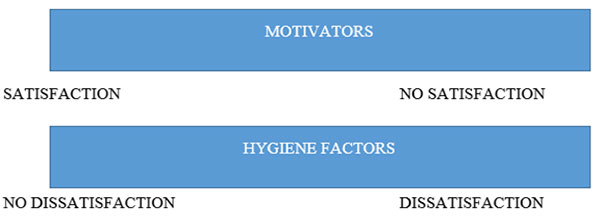
Source Management study guide:
https://managementstudyguide.com/herzbergs-theory-motivation.htm
Figure 1: Hertzberg’s Motivational Theory
Socio-Demographic Characteristics of the Respondents
The majority of the respondents were females 55.2% (191) while males were 44.8% (155). This shows that both genders were significantly represented in the study with an almost equal rate of representation. In terms of the age of the respondents in years, more than half of the respondents as shown by 55.8% (193) were aged 31-40 years. The majority of the HCWs as indicated by 63.9% (221) were married while another majority as shown by 68.8% (238) had a college level of education. According to the responses, a total of 62.4% (355) had worked in the respective facility for duration of a 6 or more years. About half of the participants, with a percentage of 49.1% (170) disclosed that they earned a salary ranging between KES 50, 000 to KES 100, 000 (see Table 1).
Table 1: Distribution of the Respondents by Different Socio-Demographic Characteristics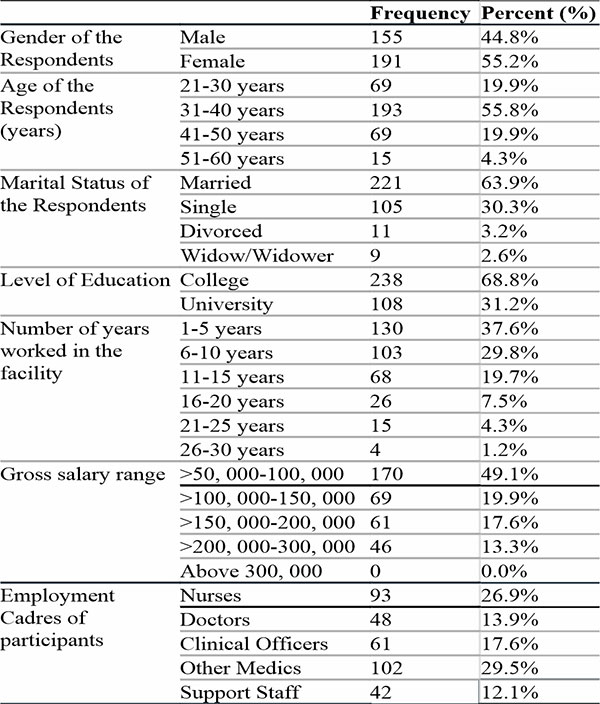
Table 2: Status of motivational Factors affecting Healthcare workers satisfaction/dissatisfaction in Public Hospitals in Nairobi County, Kenya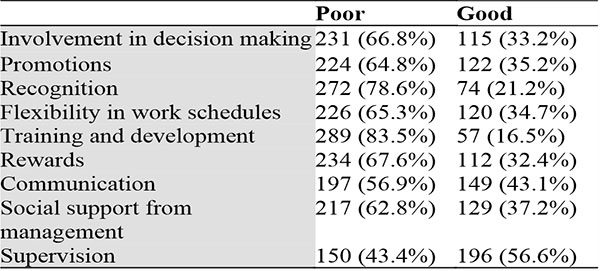
From Table 2, 37.6% (130) of the respondents think that involvement in decision-making is poor. On promotions, 43.1% (149) indicated that it is poor. Recognition as disclosed by 48.0% (166) is poor. According to 32.9% (114) of the respondents, flexibility in work schedules in the workplace is poor. Respondents exceeding half, 57.8% (200) indicated that the status of training and development is poor. According to 54.4% (188), rewards in public hospitals in Nairobi County are fair. Also evident is that 29.2% (101) indicated that communication is poor, and 27.7% (96) indicated fair communication status. In terms of the status of social support from the management, 38.2% (132) indicated fair status, and 24.6% (85) indicated poor status. Based on 30.9% (107) of the respondents, supervision is good; 29.8% (103) indicated poor supervision status.
Table 3 Likert Scale Responses on Influence of Motivational Factors on satisfaction/dissatisfaction by HCWs in Public Hospitals in Nairobi County, Kenya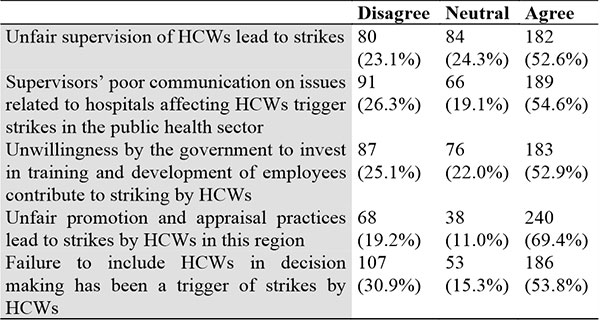
Respondents were also presented with Likert scale items where they were required to indicate how much they agreed/disagreed on the influence of motivational factors on strikes by HCWs. The findings are tabulated in Table 3.
According to 52.6% (182) of the respondents who agreed, unfair supervision of HCWs leads to strikes. Further, 54.6% (189) of the respondents were in agreement that supervisors’ poor communication on issues related to hospitals affecting HCWs triggers strikes in the public health sector. In total, 52.9% (183) of the respondents were in agreement that the unwillingness of the government to invest in the training and development of employees contributed to striking by HCWs. From a response of 69.4% (240) of the respondents who agreed and strongly agreed, it is evident that unfair promotion and appraisal practices lead to strikes by HCWs in this region. Lastly, failure to include HCWs in decision-making has been a trigger of strikes by HCWs as shown by 53.8% (186) of the respondents in agreement.
Inferential Statistics on motivational Factors contributing to satisfaction/dissatisfaction among Healthcare Workers in Public Hospitals in Nairobi County, Kenya.
Table 4: Chi-Square Results on motivational Factors contributing to satisfaction/dissatisfaction among Healthcare Workers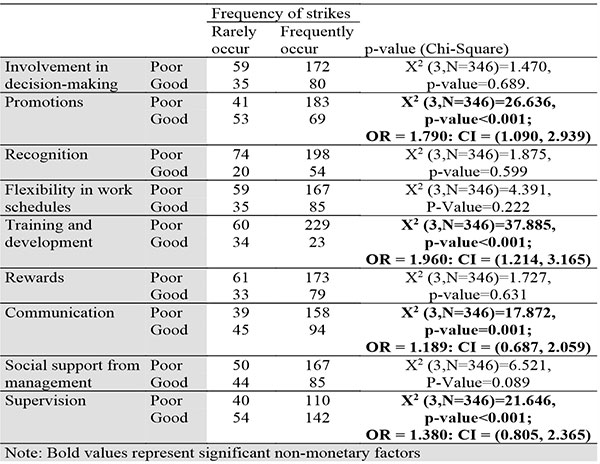
Chi-square results in Table 4 demonstrate that promotions ( X^2 (3,N=346)=26.636,p-value<0.001) with OR =1.790 (poor status category as the baseline) and CI = (1.090, 2.939) had a statistically significant effect on strikes by HCWs. Therefore, HCWs who perceived promotions to be poor were 1.790 times more likely to engage in strikes. Training and development (X^2 (3,N=346)=37.885, p-value<0.001) with OR = 1.960 with CI = (1.214, 3.165) for poor status as the baseline had a significant effect on strikes by HCWs. If HCWs perceived training and development to be poor, then they were 1.960 times more likely to engage in strikes. Communication (X^2 (3,N=346)=17.872,p-value=0.001) with OR = 1.189 and CI = (0.687, 2.059) with poor communication as the baseline had a significant effect on strikes. This shows that if communication was poor then it was 1.189 times more likely for HCWs to engage in strikes. Supervision (X^2 (3,N=346)=21.646,P-Value < 0.001) with OR = 1.380 and CI = (0.805, 2.365) with poor supervision as the baseline had a statistically significant effect on strikes by HCWs. It was 1.380 times more likely for HCWs to engage in strikes if supervision was perceived to be poor.
Hygiene Factors affecting Healthcare workers' satisfaction/dissatisfaction in Public Hospitals in Nairobi County, Kenya
Table 5 Status of Hygiene Factors affecting Healthcare workers satisfaction/dissatisfaction in Public Hospitals in Nairobi County, Kenya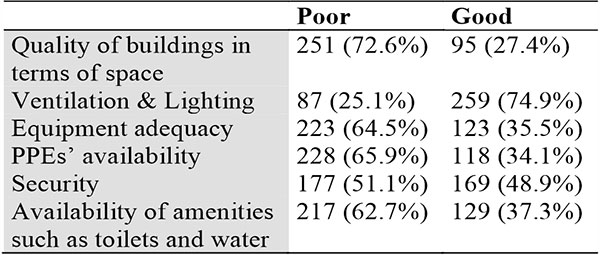
According to 43.4% (150) of the respondents, the quality of buildings in terms of space was poor. Based on 52.6% (182) of the respondents, ventilation and lighting in public hospitals of Nairobi County are good. According to 43.1% (149) of the respondents, equipment adequacy in the hospitals was poor. In terms of PPEs’ availability, 37.3% (129) indicated that they are fairly available; 28.6% (99) indicated the poor status of PPEs’ availability. Based on 32.9% (114) and 27.7% (96) of the respondents, security in public hospitals in Nairobi County is fair and good respectively. It is also evident that based on 45.4% (157) of the respondents the status of amenities available such as toilets and water in public hospitals located in Nairobi County is fair. More than half of the respondents with a total of 67.1% (232) thought that the status of their salaries was either poor or fair.
Respondents were presented with Likert scale items on the influence of Hygiene factors on strikes among Healthcare workers in public hospitals in Nairobi County. The findings are shown in Table 6.
Table 6 Likert Scale Responses on Influence of Hygiene Factors on HCWs satisfaction/dissatisfaction in Public Hospitals in Nairobi County, Kenya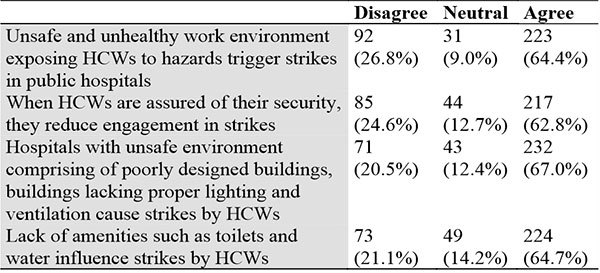
Based on a total of 64.4% (223) of the respondents who agreed, unsafe and unhealthy work environments exposing HCWs to hazards trigger strikes in public hospitals. According to a total of 62.8% (217) who agreed, when HCWs are assured of their security, they reduce engagement in strikes. In total, 67.0% (232) of the respondents were in agreement that hospitals with unsafe environments comprising poorly designed buildings, buildings lacking and proper lighting and ventilation cause strikes by HCWs. 64.7% (224) of the respondents were in agreement that lack of amenities such as toilets and water influence strikes by HCWs. Lastly, 70.5% (244) of the respondents agreed and strongly agreed that low salary payment has a significant effect on strikes by HCWs.
Inferential Statistics on Hygiene Contributing to satisfaction/dissatisfaction among Healthcare Workers in Public Hospitals in Nairobi County
Table 7 Chi-Square Results of Hygiene Factors Contributing to satisfaction/dissatisfaction among Healthcare Workers in Public Hospitals in Nairobi County, Kenya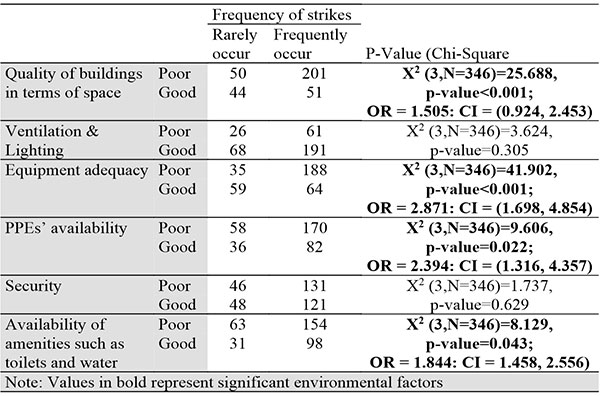
Chi-square results for the association between environmental factors and strikes by HCWs in Table 7 demonstrate that the quality of buildings in terms of space (X^2 (3,N=346)=25.688, p-value<0.001) with OR = 1.505 and CI = (0.924, 2.453) with the baseline being “poor status” had a significant effect on strikes by HCWs in Nairobi County. It is 1.505 times more likely for HCWs to engage in strikes if they perceive that the status of quality of buildings in terms of space is poor. Equipment adequacy (X^2 (3,N=346)=41.902, p-value<0.001) with OR = 2.871 and CI = (1.698, 4.854) with “poor status” as the baseline had a significant effect on strikes by HCWs. It was therefore 2.871 times more likely for HCWs to take part in strikes if they perceived the status of equipment adequacy to be poor. Availability of PPEs’ (X^2 (3,N=346)=9.606, p-value=0.022) with OR = 2.394 and CI = (1.316, 4.357) with “poor status” as the baseline had a statistically significant effect on strikes by HCWs. It was 2.394 times more likely for HCWs to engage in strikes if they perceived the status of PPEs’ availability to be poor. Availability of amenities such as toilets and water (X^2 (3,N=346)=8.129, p-value=0.04) with OR = 1.844 and CI = (1.458, 2.556) with “poor status” as the baseline had a significant effect on strikes by HCWs. It was therefore 1.844 times more likely for HCWs to engage in strikes if they perceived the availability of amenities such as toilets and water to be poor. Salary status (X^2 (3,N=346)=39.248, p-value<0.001) had a statistically significant effect on engagement in strikes. The odds ratio (OR) = 3.610 with confidence interval (CI) = 2.072, 6.289) for those whose salary status is poor. Therefore, those with poor salary status are 3.610 times more likely to engage in strikes as compared to other better salary statuses.
Discussion
The Chi-square results demonstrated that promotions, training and development, communication, and supervision contributed significantly to strikes by HCWs. The findings concur with Kibwana et al., (2018) who conducted a study in Ethiopia and found supervision aspects such as fairness and availability of supervisors to respond to issues related to employees affected by strikes by HCWs in Ethiopia. Daneshkohan et al., (2020) undertook a study in Iran and revealed supervision to have a significant effect on strikes by HCWs. The results of the study on training and development as a significant factor leading to strikes agree with Rahayu et al., (2019) who demonstrated that an organization’s unwillingness to invest in training and development of employees contributed to strikes in the long run.
The findings of the study also agree with Du Plessis and Van Niekerk (2017) who found that motivational factors linked to unrest comprise roles in decision-making, promotions, recognition, flexible working conditions, training and development, and communication. Further Kassa (2022) found that job enrichment is a key motivational factor associated with strikes. This is also the opinion of Ochola (2018) who noted that employees’ training and availing training opportunities enable employees to have a feeling of being empowered and thus committed to their work.
Chi-square results for the association between Hygiene factors and strikes by HCWs demonstrated that the quality of buildings in terms of space, equipment adequacy, PPEs’ availability, availability of amenities such as toilets and water, and salaries significantly influence strikes by HCWs. These findings are in agreement with Prasad (2019) who conducted a study in West Bengal and noted that the work environment should be safe and healthy to protect employees from hazards and also enhance good mental health and well-being in addition to personal safety.
Sev and Aslan (2022) demonstrated that a work environment that is not safe directly influences workers taking part in strikes. Haj and Jubran (2021) found that assurance of employees’ safety and health reduces the likelihood of them taking part in industrial unrest. A study by Ashkanasy et al., (2021) noted that sectors whose environment is unsafe such as containing poorly designed buildings, lack of ventilation, poor lighting, and poor safety measures are unhealthy for employees and lead to unrest. The findings further support Akpan and Obisung’s (2022) results that demonstrated that a lack of PPEs affects employees’ safety resulting in industrial unrest. When HCWs lack PPE, they are exposed to occupational and communicable diseases which can trigger strikes (JH Verbeek, 2020). Further, Zamani (2023) thought that physical environments such as poorly designed consultation rooms, poorly ventilated hospital halls, lack of sufficient space and furniture, and lack of social amenities such as toilets lead to strikes by HCWs. In a study by On’ngonge (2022), security, cleanliness, and amenities availability were the physical factors that influenced employees’ engagement in unrest. In a Kenyan study by Githatu (2022), working conditions that are unsafe and unhealthy influence unrest in the workplace. In Indonesia, Hamid and Wabisana (2022) found that salary amounts and payment dates significantly affected unrest in the health sector. The findings also agree with Fernando (2020) who conducted a study in Sri Lanka's airline sector and found that salary amount, delays, and discrepancies influence engagement in strikes.
Conclusion
The objective of this study was to determine the Motivational and Hygiene factors that influence healthcare workers' satisfaction/Dissatisfaction levels. It can be concluded that there are motivational factors that have an influence on healthcare workers' satisfaction/Dissatisfaction levels. Some of the motivational factors affecting healthcare workers' satisfaction/Dissatisfaction levels in public hospitals include promotions, training and development, communication, and supervision. Therefore, the employer should come up with clear guidelines on rewards based on non-monetary factors such as merit-based promotions, training, and development opportunities through programs such as in-service training and compensation for extra training that HCWs incur expenses for. Further, It can also be concluded that there are Hygiene factors that have an influence on healthcare workers' satisfaction/Dissatisfaction levels in public hospitals. Some of the significant Hygiene factors influencing healthcare workers' satisfaction/Dissatisfaction levels include quality of buildings in terms of space, equipment adequacy, PPEs’ availability, availability of amenities such as toilets and water, and salary status. The study recommends that more resources should be invested towards the construction of more hospital spaces and improving the quality of the available hospital spaces.
Ethical Considerations
The researcher was issued a letter of introduction and an Ethical committee clearance letter from Mount Kenya University’s Ethical review committee. Later, a research permit was granted by the National Commission for Science, Technology, and Innovation (NACOSTI). This was then followed by a letter of research authorization from Nairobi City County and later a research authorization from each healthcare facility before proceeding to collect data. Participation in the study was voluntary, and all respondents were briefed thoroughly before signing an Informed consent. The identities of the participants were not revealed and any other identifiable data was not collected for confidentiality and anonymity reasons. Filled questionnaires were collected by the principal investigator and stored safely from unauthorized persons. The manuscript was run using turn-it-in anti-plagiarism software to ensure that the research was free of plagiarism.
References
- Advanced research computing. (2022, June 19). Statistical methods and data analytics. Retrieved from stats.oarc.ucla.edu: https://stats.oarc.ucla.edu/spss/faq/what-does-cronbachs-alpha-mean/#:~:text=Cronbach's%20alpha%20is%20a%20measure,that%20the%20measure%20is%20unidimensional.
- AL JAZEERA. (2017). Kenya doctors end strike after deal with government. https://www.aljazeera.com/news/2017/3/15/kenya-doctors-end-strike-after-deal-with-government.
- Akin-Otiko, B. O., Adamolekun, M. M., & Amoka, J. R. (2019). Nurses’ Perception of Causes of 2015 Strikes at Federal Medical Centre Owerri: Implication for Preventive Strategies. International Journal of Health Economics and Policy, 4(4), 132-142.
- Ampofo, P. O., Tenkorang-Twum, D., Adjorlolo, S., Chandi, M. G., Wuni, F. K., Asiedu, E., & Opoku, S. (2022). The impact of strike action by Ghana registered nurses and midwives on the access to and utilization of healthcare services. Plos one, 17(10), e0275661.
- Chima, S. C. (2018, 12 19). Global medicine: Is it ethical or morally justifiable for doctors and other healthcare workers to go on strike? BMC Medical Ethics: https://doi.org/10.1186/1472-6939-14-S1-S5
- Essex, R. &. (2022, August). The justification for strike action in healthcare: A systematic critical interpretive synthesis. Nursing ethics,. National Library of Medicine: https://www.ncbi.nlm.nih.gov/pmc/articles/PMC9442631/
- Eruaga, O. A., Osiki, A., & Ubi-Abai, I. (2023). Nigeria’s Political, Economic, and Social Dynamics in a Pandemic Era. In The First 100 Days of Covid-19: Law and Political Economy of the Global Policy Response (pp. 235-272).
- Hamid, A., & Wibisana, A. W. (2022). The implementation of labor strike rights: Between freedom and order in Indonesia. International Journal of Research in Business and Social Science (2147-4478), 11(3), 257-264.
- Hamark, J. (2021, October 19). Strikes and lockouts: The need to separate labor conflicts. Journals.sagepub.com: https://doi.org/10.1177/0143831X211049274
- Human Rights Watch. (2021, October 21). Kenya: Pandemic health workers lack protection. www.hrw.org:https://www.hrw.org/news/2021/10/21/kenya-pandemic-healthworkers-lack-protection
IntraHealth, I. (2021, October 17). Health Workers in Kenya Use New Negotiation Skills to Improve Their Working Conditions. Retrieved from IntraHealth International.: https://www.intrahealth.org/vital/health-workers-kenya-use-new-negotiation-skills-improve-their-working-conditions - Kaguthi, G. N. (2020). The impact of the nurses’, doctors’, and clinical officer strikes on mortality in four health facilities in Kenya. BMC Health Services Research, 469.
- Leona R. Zboril-Benson. (2012). Why Nurses Are Calling in Sick: The Impact of Health-Care Restructuring. Canadian Journal of Nursing Research, Volume 33, issue 4. https://cjnr.archive.mcgill.ca/article/view/1660
- Mosadeghrad A.M. (2019). Factors influencing healthcare service quality. International journal of health policy and management, 77-89. https://www.ncbi.nlm.nih.gov/pmc/articles/PMC4122083/
- Mudaly, P., & Nkosi, Z. Z. (2015). Factors influencing nurse absenteeism in a general hospital in Durban, South Africa. Journal of Nursing Management, 23(5), 623–631. https://doi.org/10.1111/jonm.12189
- Muthoni, K. C. (2019). ASSESSMENT OF HEALTH FINANCING FACTORS AFFECTING PERFORMANCE OF SERVICE DELIVERY AT PRIMARY HEALTH CARE FACILITIES IN MOMBASA COUNTY, KENYA. Nairobi.
Nation Media Group. (2020, September 21). Nation. https://nation.africa/kenya/news/nearly-5-000-knh-workers-threaten-strike-over-delayed-higher-salaries-2304620 - Russo, G., Xu, L., McIsaac, M., Matsika-Claquin, M. D., Dhillon, I., McPake, B., & Campbell, J. (2019). Health workers’ strikes in low-income countries: the available evidence. Bulletin of the World Health Organization, 97(7), 460.
- Saad, S. G., & Hasanein, A. M. (2018). Impact of Herzberg’s theory on job satisfaction and organizational commitment in Egyptian hotels: Frontline employees-case study. Egyptian Journal of Tourism Studies Vol, 17(1).
- Siddiqui, M. U., & Vishwakarma, V. (2023). Impact of Compensation Practice on Employee Informatics a study of Vindhyanchal NTPC Singrauli (MP). International Journal of Advances in Social Sciences, 11(4), 203-210.
- Sorcha A. Brophy, (2022). Heroes on Strike: Trends in Global Health Worker Protests During COVID-19. Accountability Note. https://accountabilityresearch.org/publication/heroes-on-strike-trends-in-global-health-worker-protests-during-covid-19/
- The Guardian. (2023). US healthcare workers focus on pay and understaffing in fight for new contracts. https://www.theguardian.com/us-news/2023/aug/03/hospital-workers-strike-kaiser-permanente
- Vincent, L. M., & Gichinga, L. (2017). Factors influencing industrial unrest in the public sector in Kenya: a case study of Coast Provincial General Hospital. International Journal of Sciences: Basic and Applied Research, 32(3), 287-304.
- Waithaka, D. K. (2020). Perspectives and experiences of frontline health managers. International Journal for Equity in Health, 23.
- Wasike, A. (2017). 100-day doctors' strike ends in Kenya. Retrieved from World Africa: https://www.aa.com.tr/en/africa/100-day-doctors-strike-ends-in-kenya-/771512
- WHO. (2018). Delivering quality health services: a global imperative for universal health coverage. https://apps.who.int/iris/bitstream/handle/10665/272465/9789241513906-eng.pdf
- Xinhua. (2021). Kenya's health workers' strike imperils efforts to flatten the COVID-19 curve. http://www.xinhuanet.com/english/2021-01/13/c_139665172.htm